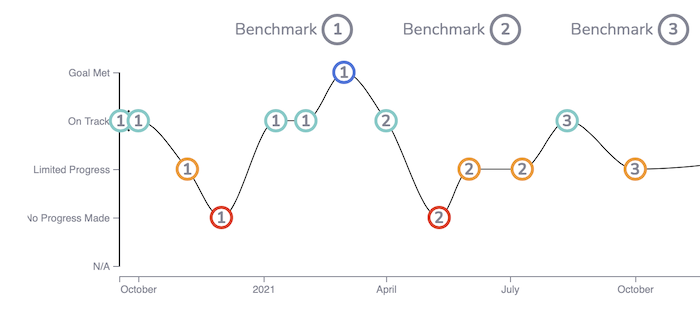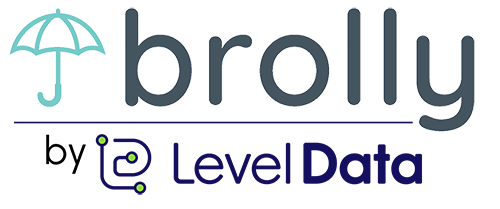Free Guide to Progress Monitoring
This in-depth guide to progress monitoring provides a foundation of information and understanding about progress monitoring in special education.
GO TO A SECTION:
What is progress monitoring?
Is progress monitoring required?
Why is progress monitoring important in special education?
How is progress monitored?
How often is progress monitored?
What if a student isn’t making progress?
How is data collected?
How to progress monitor with Brolly
Sample Assessments
What is progress monitoring?
Progress monitoring is a way to measure a student’s response to instruction. It’s a formative assessment, meaning student learning is evaluated (or monitored) on a regular basis. This helps educators understand how a student is responding to instruction and make needed changes to instruction in a timely manner.
A student’s IEP will state how their progress toward meeting each goal will be monitored or evaluated. According to the IRISCenter, the most appropriate progress monitoring systems are where objective numerical data are collected frequently, graphed, analyzed and used to make instructional decision.
Progress monitoring assessments should not be subjective. Examples of valid measurements are behavior observation checklists, assessments like math or reading, or chapter test scores.
Progress may be monitored towards an IEP goal, or a set of subgoals called benchmarks or objectives. It’s important that an IEP goal tracking tool provides the ability to log for benchmarks or objectives as well as the overall IEP goal in order to provide early indication on how effective instruction or intervention is for student learning.

Is progress monitoring required?
Individuals with Disabilities Education Act, or IDEA, is the US special education law that governs how states and public agencies provide early intervention, special education, and related services to children with disabilities.
Under IDEA, each child with a disability receives an IEP. An IEP is a legally binding document that includes the child’s:
- current academic achievement and functional performance
- measurable annual goals – referred to as the IEP goal
- how the child’s progress toward meeting the annual goals will be measured, and when reports will be provided
- special education and related services that will be provided along with program modifications for school personnel that will be provided to support the child’s progress
- the extent, if any, that child will not participate in the general education classroom
- individual accommodations necessary to measure academic achievement and functional performance of the child on State and district wide assessments, or if they should take alternative assessments and why
- projected date for beginning the services and modifications as well as the anticipated frequency, location and duration of the modifications and services
- transition services (included once they reach 16 years old)
While IDEA part B expands far beyond IEP definitions, this clause requires that progress is monitored toward meeting the IEP goal.
Why is monitoring student progress important in special education?
Beyond being required by law, progress monitoring is an important component of student achievement. Measuring progress towards an IEP goal is critical to understanding if the instruction is helping the student. It provides early insight if an adjustment to instruction or additional services are needed to help the child make meaningful progress.
Well-written IEP goals are challenging, ambitious and measurable. An example of an IEP goal is “When given 10 word problems at a third grade level, <student name> will calculate the problems with at least 80% accuracy on 3 trials by the end of the school year.” Progress towards this goal is then measured on a regular basis. The outcome of the progress assessment is typically collected in a software that creates a graph of the progress. Here’s an example of Brolly’s progress monitoring graph..

How is progress monitored?
Progress is monitored through assessments, also referred to as tests, probes or measures. These are brief, formative assessments that are scored, but no grades are assigned. Conversely, summative assessments measure learning after instruction and are often graded.
There are two common ways to measure progress. Curriculum based measurement (CBM) which is also referred to as general outcome measurement (GOM) and mastery measurement (or MM).
MM measures a specific skill or sub-skill. A skill may be broken down into a series of sub-skills (often referred to as objectives or benchmarks). Once a student achieves mastery in one skill they progress to the next.
GOM measures growth across a year. GOM is used to measure if a student gained a new skill and retained their previous skills. A GOM uses alternative versions of assessments. For example, a GOM may be used to measure progress monthly, and each test will have equivalent content.
An easy way to understand the different types of progress monitoring is imagining a math test. MM assessments might have 15 single-digit by single-digit multiplication problems. Conversely, a GOM assessment includes a variety of single and multiple-digit multiplication and division problems.
How often is progress monitored?
The frequency of progress monitoring will be defined in the student’s IEP.
It’s important to measure progress frequently and in a systematic way, for example every two weeks, to support data-based adjustments to instruction. If progress isn’t measured frequently enough, then teachers and providers won’t have sufficient data to make timely adjustments that improve student achievement.
What if a student isn’t making progress?
If a student is not making progress towards their IEP goal the IEP team will reconvene to ascertain the cause. They will assess:
-
- Is the IEP being followed?
- Is it being implemented properly? Is the student receiving the services and supports they’re entitled to?
- Are there other causes for the lack of progress?
- How ongoing progress monitoring will be conducted.
IEP goal tracking software that consolidates service session tracking as well as progress monitoring can be a valuable tool during this conversation.
Oftentimes, teachers and providers track service minutes on paper or a spreadsheet. In that case, an IEP team would have to get in touch with every professional providing services to the student and request their logs. The team would then aggregate all the data into a meaningful format or spend time sifting through it all at the meeting.
Specialized IEP goal tracking software provides these teams real-time data. In just a few moments they can export a report which includes each of the student’s IEP goals as well as a summary of all the service sessions provided between the progress assessments.
With a quick scan, IEP teams can begin to answer the above questions utilizing data, rather than subjective narratives or incomplete notes. They can clearly see if service logs are missing, there was a change in the instruction approach, and whether progress has stalled for one goal or across goals.
Example
Christine has IEP goals for reading, writing, and math. Her math teacher monitors progress every two weeks and collects data. Similarly, her reading provider progress monitors every week. Christine is not making adequate progress towards her math IEP goal, so the IEP team reconvenes. They begin to answer each of the questions to the left.
The team determines the IEP is being adhered to. They look at her Brolly student report and find that she is being provided the services she is entitled to.
What could be causing this delay in progress? Taking a moment to read through her recent math session notes, they find that she has started word problems. Christine’s reading teachers chimes in. Christine struggles with reading comprehension, something they’re working on. Ultimately, the team determines Christine is having difficulty understanding the word problem, not with the math formula. The team uses their expertise to identify adjustments to the specially designed instruction to better support Christine.
How is data collected?
Summative assessments are recorded less frequently. They’re often sent to parents and are typically recorded in a school’s IEP management system.
Formative assessments may be collected in a variety of tools including pen & paper, spreadsheets, or IEP goal tracking software.
The pen & paper method is simple – a major benefit for staff with limited time for data collection. It’s intuitive, fast, and muscle memory for many experienced teachers.
It also has its downsides. The sheer volume of documentation required makes collecting data on paper cumbersome and carrying heavy binders across-campus is exhausting. It also creates a major hurdle for administrators, who have no visibility into service provision or progress until an IEP meeting.
Spreadsheets reduce many of the issues posed by collecting progress data with pen & paper, like accessibility. A teacher or provider can house all their student’s IEP tracking on a computer.
Conversely, managing each spreadsheet, creating formulas, and updating IEP goals can create hours of work. From an administrator’s perspective, spreadsheets are often too detailed. Even with access to a shared workbook, it’s hard to merge the data into a high-level perspective.
Like the other methods, IEP goal tracking software has benefits and drawbacks. These platforms are designed for logging IEP data and are relatively new to the scene. Because of their novelty, a special education leader may not be aware the solution exists. Teachers and providers may be resistant to adopting another platform.
IEP goal tracking apps may help your providers become more efficient at data collection. Templates, pre-populated caseloads, and IEP goal imports reduce administrative burden on your staff. The power of IEP goal tracking software is in the transparency it provides administrators. The information they need is in real-time dashboards and reports. Leaders can take a proactive approach to compliance and student achievement.
Learn about the pros and cons of various progress monitoring tools here.
Progress Monitoring with Brolly
Brolly features robust dashboards that empower special education administrators with visibility into progress and services throughout their school or district. These dashboards are fed with real-time data collected through our service tracking and progress monitoring forms.
To collect progress monitoring data, the provider selects the student or students from their caseload. They’ll add the date that progress was monitored as well as the assessment used- information that populates to each student’s record. Next, the provider selects the applicable goal, objective, or benchmark that the progress being monitored for and adds the assessment score. They’ll then select the progress status (no progress, limited progress, on track, or goal met) and attach an image if desired.
Templates make this process even easier for group sessions. Each student’s name, applicable IEP goal, and the assessment is auto filled. The provider inputs the assessment score and progress status for each student then submits the form.
The data collected automatically updates the dashboard and reporting functions with the new information. Teachers, providers and administrators can view a graph of the student progress or export a report for an external stakeholder. If you’d like to see this feature in action, book a demo with our team!
Sample Assessments
There are a variety of assessments that can be used for progress monitoring. We’ve already covered two common types of progress monitoring, MM and GOM. Both of these assessment types are valid for monitoring progress. Depending on the IEP goal, an IEP team may select one of these methods to monitor a student’s progress, or they may determine another assessment method is a better fit.
- Instruments like DIBELS or AIMSweb
- Observational checklists
- Worksheets
- Essays
- Task completion
- Oral presentations
Want to learn more about progress monitoring?
Find out how Brolly can unify your service tracking and progress monitoring in one simple app!
Citation
Vanderbilt. “Intensive Intervention (Part 2): Collecting and Analyzing Data for Data-Based Individualization, Page 3 Progress Monitoring” IRISCenter, https://iris.peabody.vanderbilt.edu/module/dbi2/cresource/q2/p03/, July 2022.
Vanderbilt. “Progress Monitoring: Mastery Measurement vs. General Outcome Measurement” IRISCenter, https://iris.peabody.vanderbilt.edu/wp-content/uploads/modules/pmr/pdf/IRIS_PM_InfoBrief_011420.pdf#content, July 2022.
Vanderbilt. “Formative Assessment” IRISCenter, https://iris.peabody.vanderbilt.edu/module/pmm/cresource/q1/p01/#content, July 2022.
Vanderbilt. “Monitoring & Reporting Student Data” IRISCenter, https://iris.peabody.vanderbilt.edu/module/iep01/cresource/q3/p09/ , July 2022.
U.S. Department of Education, “The Individuals with Disabilities Education Act (IDEA) Regulations.” https://www2.ed.gov/policy/speced/reg/idea/part-b/index.html, July 2022.
U.S. Department of Education, 20 USC Chapter 33, Subchapter II: § 1414, https://uscode.house.gov/view.xhtml?path=/prelim@title20/chapter33/subchapter2&edition=prelim
